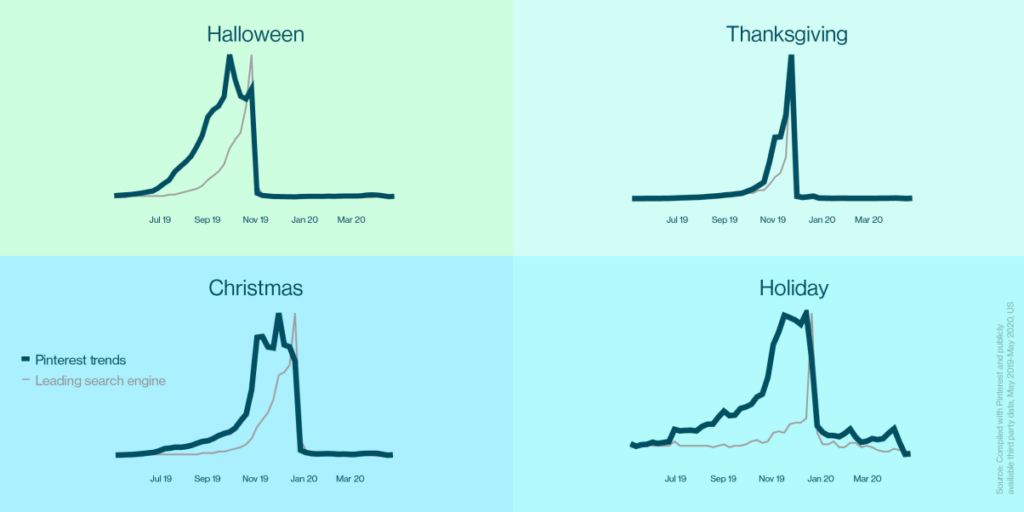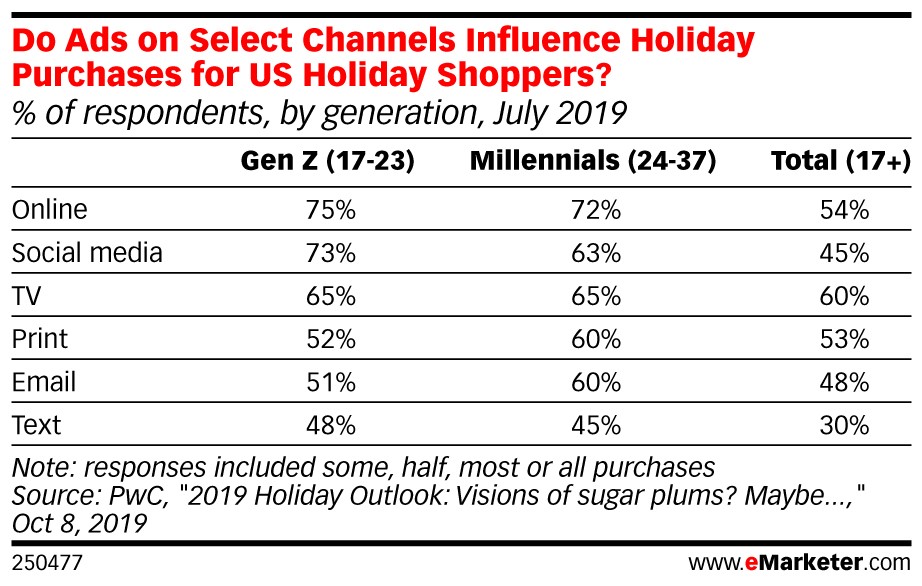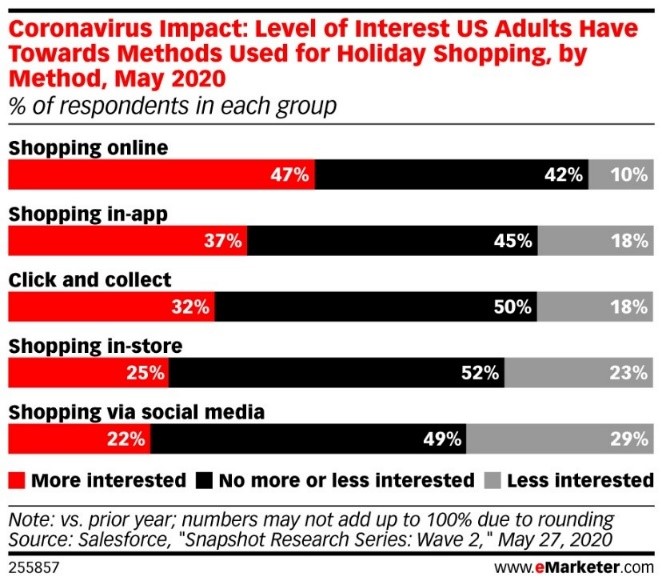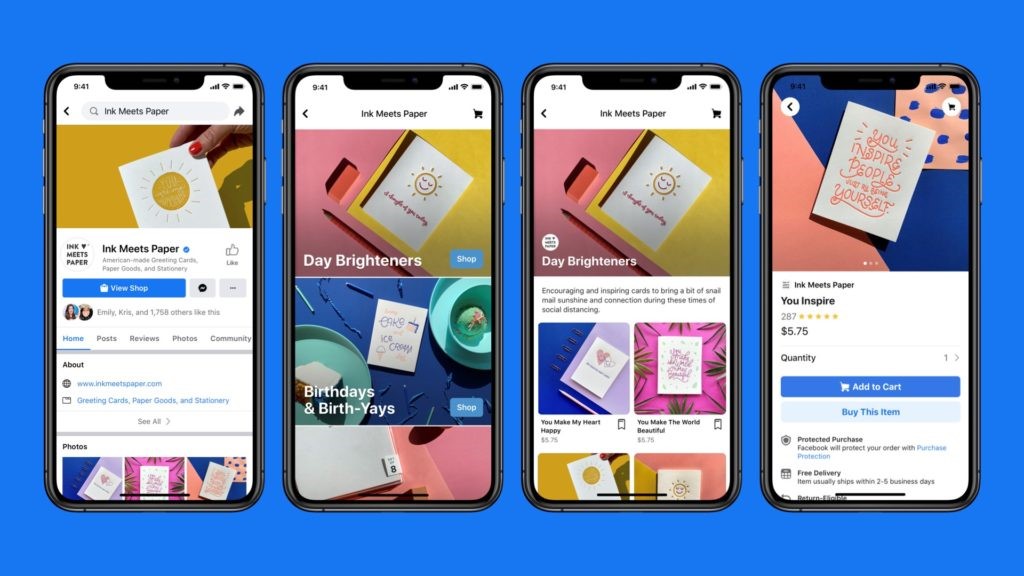
14 Sep 5 Social Media Tactics to Enhance Your 2020 Holiday Marketing Strategy
The holiday season has traditionally been the largest revenue generator of the year for major brands and retailers, but 2020 has marketers taking their typical playbooks and throwing them out the window.
In large due to the coronavirus pandemic, consumer behaviors have shifted across the board. Not only are people using social media differently, but purchase behaviors have changed. What was intended to be a short lockdown has now spanned over the course of 6+ months. We saw a preview of this with early indications that back-to-school shopping has not been as successful for retailers as it has been in year’s past.
That said, the holiday season is around the corner. Whether you’re just starting to develop your plan or adapting your existing strategy, the following outlines numerous social media tactics your brand can utilize to enhance your 2020 holiday marketing strategy.
Key Takeaways
- Plan content & paid media around key dates and for high impact channels
- Past holiday messages won’t resonate the same this year
- Video & Live video are getting priority in feeds
- If considering influencers, secure them now
- Things are still changing daily, so build flexibility into your plan
Holiday 2020: A New Landscape
Before we dive into our tactics, let’s take a step back and understand the holiday 2020 landscape. Last year holiday shopping shifted vastly to favor e-commerce, and Cyber Monday alone was the heaviest online spending day in history. It jumped about 20% from the prior-year bringing in $9.4 billion in revenue, according to Adobe.
This shift was propelled by younger generations, Gen Z and Millennials, spending more time shopping, getting more buying power as they get older, and leading the growth of e-commerce. But we’re also seeing Boomers and older generations becoming more comfortable with online shopping. And honestly, a lot of that had to do with the recent pandemic. When consumers needed to buy products, brick-and-mortar stores were shutting down, somewhat forcing people to rely on e-commerce. As a result, 33% of consumers during this time increased their online spending. Of that 33%, about 23% fall into that older generation category. Also, to put the last couple of months into perspective, e-commerce grew more during the pandemic in an eight-week time-period than it did the entire decade before.
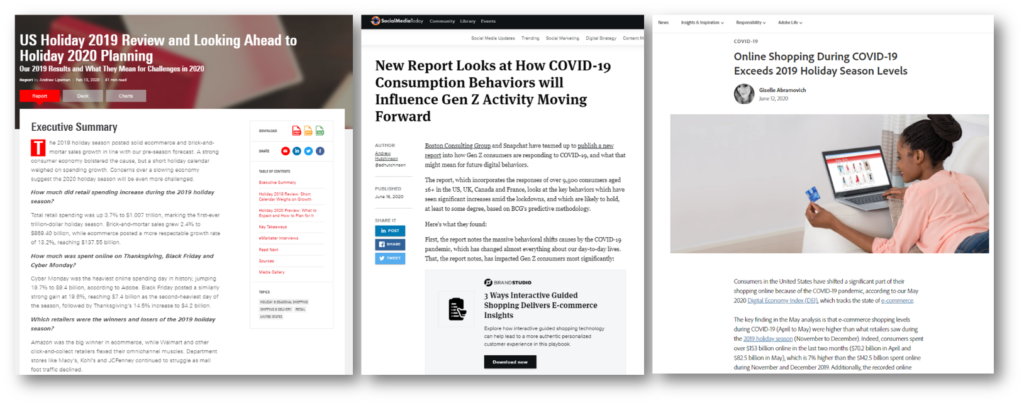
And there’s a couple of reasons for that. As we just mentioned there was a shift from brick-and-mortar to e-commerce experiences, but there was also the increasing rise of digital-only products and services being offered. Mobile shopping also increased, especially with some of these new-to-online shoppers.
Now, there are some concerns with the economy of a slowing holiday 2020 season. We do recognize there are challenges, but, according to eMarketer, some of the initial data forecasts still anticipate a growth in retail spending of about 3.4%. While not as high as years past, there’s still a lot of opportunities to reach consumers during this timeframe who are still looking to make purchases for the season.
Additionally, Pinterest has recently shared some compelling data that shows how holiday 2020 is happening earlier than ever. While we know people on Pinterest are planners, this chart proves that these users are well ahead of the game in terms of planning their purchases and their events. As you can see below, the skinny gray line represents Google Searches while the thick turquoise line represents people searching on Pinterest. It’s clear that Pinterest users are months ahead of those Google searches
While this isn’t abnormal for Pinners, what is worth noting is that in 2020 Pinterest users started searching and saving for the holidays back in April (versus September), which is a 77% jump in searches from April 2020 compared to April 2019. There’s also a 3X increase in searches for gift ideas, holiday gift ideas, Christmas, and Hanukkah gift ideas way back in April. That’s eight months before December. This proves that consumers have already been in the mindset and that numbers are going to continue to increase as we continue to approach the holiday season. Also, if you have stepped foot into retailers like Costco and Sam’s Club, the holiday decorations are in full swing.
So why the shift? There are a couple contributing factors, but the main reason stems from people being sick of the extremely challenging year and they’re looking forward to the comforts of the holiday season.
Consumers are going to want brands to step it up from years past in terms of helping them get in the holiday spirit this year.
There are still some concerns that come with this new way of life. Read on to learn more about how to combat consumer concerns and appeal to your target audience more than ever during the busy holiday time.
5 Social Media Tactics for your Holiday Marketing Strategy
1. Be Strategic with Paid Media
Our analytics and paid media team analyzed client CPM data from 2017-2019 and found that Q4 averaged a $6 CPM, which is about 15% higher than we typically see throughout the rest of the year. To help avoid some of those higher costs, start advertising earlier. However, if all brands take this approach, we will start to see CPMs go up higher and faster. Another tip to keep is to try to get your brand out of the Facebook learning phase. Once you get out of that learning phase, you’ll begin to gain some cost efficiencies.
Another item to consider is where you plan to spend those media dollars and how much towards each channel. We don’t recommend you allocate the same budgets to every channel. Instead, focus on those channels where you know your target audience is so you’re not wasting money on channels where your target won’t see your ads.
Finally, throughout the pandemic we saw a lot of budget adjustments occur and many marketers have allocated more funds to social. And you can see from the eMarketer chart, it’s a solid move as younger generations, Gen Z and Millennials, highly consider social media ads when they’re considering shopping online. If that’s your target audience, you’re going to want to move those dollars to social as well.
Pro Tip: Make sure your ads are optimized for mobile. Not only that, you’re going to want to have them optimized for conversion so as people are scrolling, they’ll be able to stop on your ad and easily convert and purchase your product, which is the ultimate goal.
2. Use Price-conscious & Relatable Messaging
With the current state of the economy, consumers have become more price-conscious. Because of this, it’s important that your brand messaging and visuals reflect this change, which is a little bit different than in years past. Roughly 40% of people are going to be celebrating on a budget this year, which is a large percentage of that consumer audience. And roughly 1/3 of that group said they’re going to wait for products to be on promotion/discount/sale before purchasing. That indicates that people are going to be doing the research; they’re going to be shopping around; they’re going to want to make sure they’re finding the best value.
To help your brand connect with these consumers, consider placing price-based and availability messaging at the forefront of your social media communication. One insight we’ve gathered from our client work is including the price, either in the copy or subtly in the image, helps with conversion, because people know what they can expect of the price point versus clicking through and dropping due to high rates.
Early bird discounts are also likely to resonate well with those consumers we previously mentioned that are only looking for deals. If you can, get ahead of the game and offer discounts before events like Cyber Monday and Black Friday. There’s no need to wait until November to go out with your deals.
Together with discounts comes the concept of free shipping. It’s becoming more of an industry standard these days as many brands and retailers are offering free shipping or shipping at a very low price point. This could be difficult for retails to follow through with as the USPS recently announced holiday surcharges for the first time ever. It’s predicted that other mail carriers will follow suit.
Regarding availability messaging, make sure your social content reflects the inventory you currently have available. There’s nothing more frustrating than seeing something that you like within a social feed, clicking through, and then finding out the product’s not in stock and/or won’t be for months. By keeping your content up to date, you’ll help increase conversions and clearly set expectations.
In addition to those above, there are a couple of other messaging points that we feel are going to really resonate this season that look a little different from years past. As you can see below from Facebook’s seasonal holiday study, they found people are going to be buying small gifts and treats for themselves. People, in difficult times, often looking for ways to stay positive and reward themselves. Facebook also found this as a trend during the 2008 recession when people were looking, again, for small affordable gifts for themselves during the holiday season. We know the holidays are typically a buying season for others, but if you can subtly include some content that has that “treat yourself” or “take care of yourself this holiday season,” message, we think it’ll definitely pay dividends.
Some other key messages that we feel will really resonate with the audience include:
Charitable and Give-back Messaging
Through the pandemic and social justice movements of 2020, we’ve seen that people truly care about the actions that businesses take beyond just the sale or beyond just the price point. They’re looking for businesses to be authentic and to put their money where their mouth is in terms of supporting causes that they care about.
Logistics: Shipping Speeds, Delivery Dates and Customer Support
We touched on this earlier, but logistics is going to be key this season. Looking at shipping speeds and delivery dates, it’s important to set the expectations of when things are going to arrive and making sure customers understand what’s available and the support that they can get. We saw social media customer care needs skyrocket in response to the pandemic this year, so get your teams ready.
Convenient, Contactless, Safe Shopping Experiences
We’ve also mentioned the rising trend on online versus in-store shopping. For those who do still want to go in-store, they’re going to want convenient, contactless, and safe shopping experiences. Make sure that’s clearly identified in your content if you are encouraging people to come in, and informing them of precautions, store hours updates, what the overall shopping experience is going to be, and more.
3. Leverage Shoppable Features
Taking into consideration the current state of the economy, we can safely assume that window shopping will be happening more online this year. And with 22% of people more interested in shopping via social and 23% of people less interested in shopping in-store, brands can leverage shoppable features directly on social networks.
Facebook and Instagram shops are the most popular shopping features currently available to marketers, and they’ve recently updated their setup. Now there’s the option for native checkout, allowing the user to buy directly off Facebook, or you have the option to push shoppers to your brand’s website. There’s also a third option to integrate third-party apps, such as Shopify. Unfortunately, these capabilities are not rolled out to all brands yet. If you don’t have access, keep an eye out and consider testing these features in the future.
TikTok has grown so much over the last few months, and on their advertising platform they now have the ability for conversion. If you’re looking at that younger audience, this might be a new tactic you can leverage.
Finally, though it’s not necessarily a shoppable feature, we do recommend buy online and pick up in-store (BOPUIS) messaging. As we previously pointed out, logistics are going to be tricky this upcoming year, but if your customers have the opportunity to buy online and then go pick up in-store so they can get their products faster rather than waiting for shipping, consider it.
4. Develop Livestream Video
We’re historically seeing Livestream and video content getting a lot of attention and prioritization by the platforms this year, especially with younger audiences. In recent research we conducted for our Gen Z vs Millennials infographic, video is king. If that’s your audience, you really want to integrate video or live stream content into your holiday marketing plan.
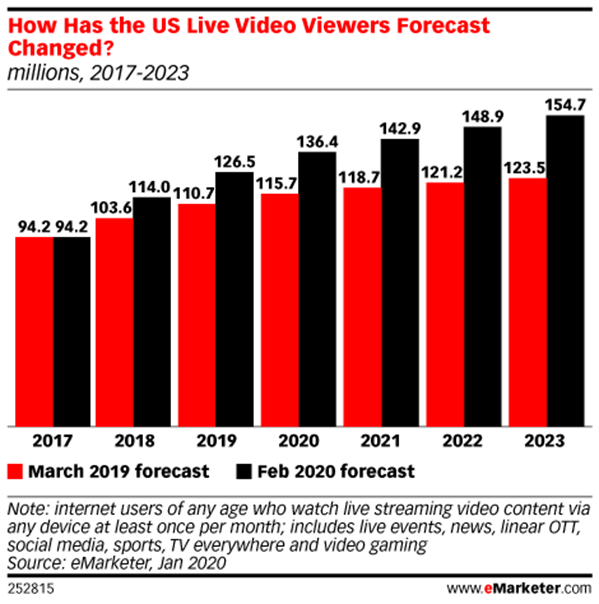
The pandemic also propelled the growth of livestreaming. Platforms are even integrating more with live video experiences, and networks such as Facebook and Instagram are enabling live shopping feature so brands can tag products from Facebook shops or a catalog within a live video. Again, these features aren’t available to everybody but keep checking your platforms to see as those slowly start to roll out.
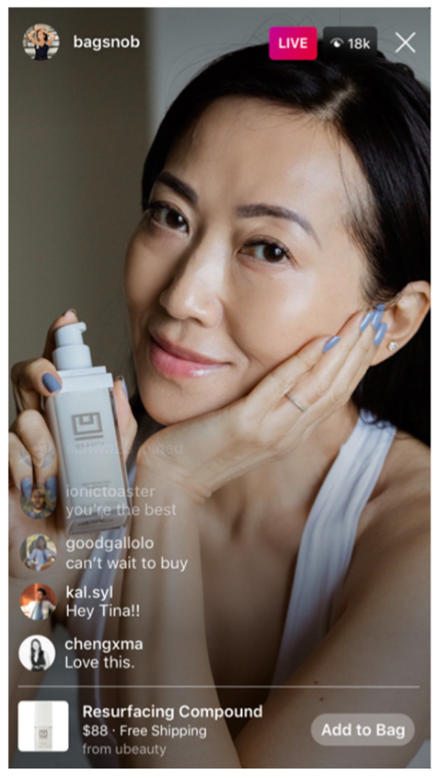
Because people won’t have the opportunity to see a product in-store as often this year, these live streams offer the ability for real-time advice, product demos, and exciting way to promote new products or limited time offers. Some things to consider are making sure you have the right talent in place, whether that’s in-house or maybe bringing in an influencer to help promote and be the host of a Livestream. Similarly, make sure you have a good understanding of what makes this a valuable piece of content that should be distributed live versus a standard video.
5. Consider Influencer Marketing
Recent data from Later and Fohr found that about 80% of influencers reported higher engagement from their followers during the pandemic, which is significant. We saw people spending a lot more time on social media this year, and as we mentioned, the holiday season is a great time to consider involving influencers in your holiday marketing strategy. They’re great resources for hosting those livestreams, creating content, and more. If you don’t have access to a studio that you once did in an office setting, influencers are a great way to develop that lifestyle, eye-catching content.
Additionally, you can leverage their audiences to help drive traffic to your website. Or if you have specific areas that you want to target, influencers are a great way to bring in that credibility.
One major consideration when working with influencers during the holiday season is that they’re likely to book up very early for the holidays, so it’s important to book them early. Also, influencers have become more selective about the brands they’re associating with. While a lot of that has to do with the pandemic and recent social justice movements, they’re aligning their values to the brand values for consistency.
BONUS: Be Flexible
As a little pre-holiday gift, we wanted to give you one more bonus tactic, which is to be flexible. You’re going to want to plan for your plan to change. If 2020 has taught us anything it’s to stay on your toes. The time between planning and execution is very large, so keep your finger on the pulse of anything that could be coming up.
There are also certain events coming up that you’re going to want to flag for your editorial calendar. Take a look at these dates and consider if you want your brand content to go side by side with the content that’s likely to be in the feeds that day (if your content isn’t buried that is).
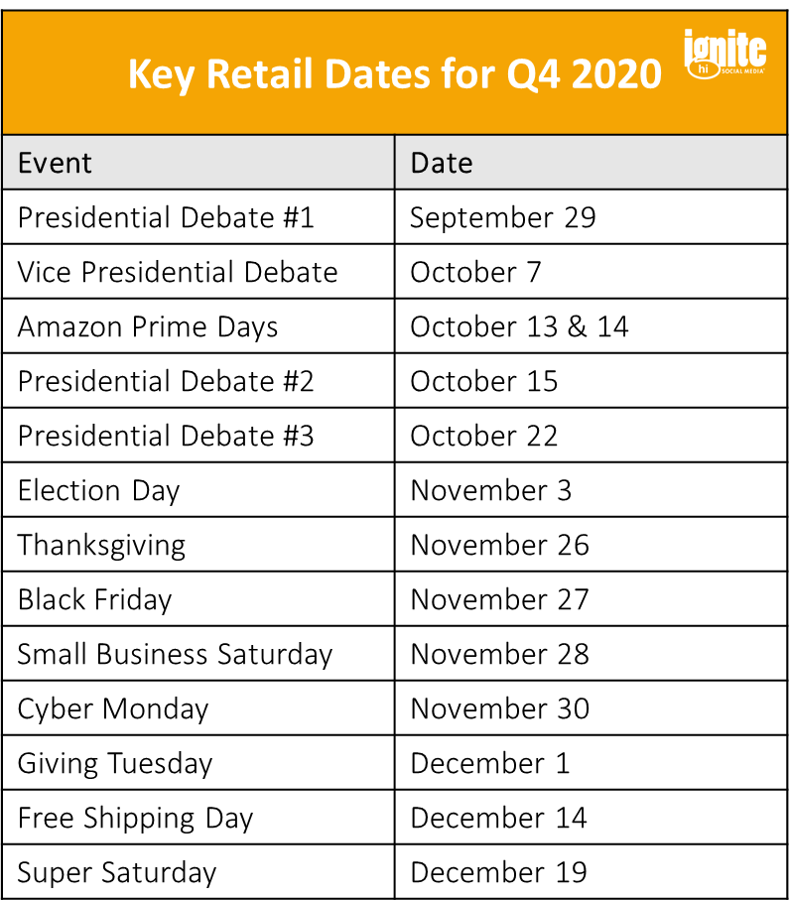
If you need help planning your social media strategy and tactics for the 2020 holiday season, send us a note, we’d be happy to help! Also, keep yourself up to date on the latest advancements and news in the social media space by subscribing to our Social You Should Know newsletter below.
Subscribe to Social You Should Know


